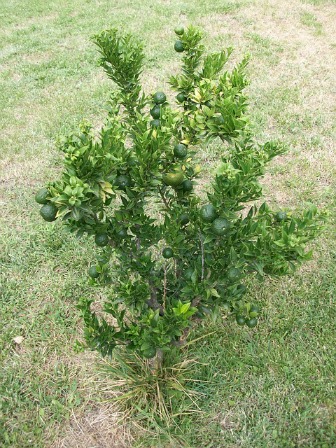These cultural practices are recommended as a reference for calamansi growing in farms:
Planting

The planting distance for growing in the orchard under monoculture ranges from 4-6 m in a square, rectangular or triangular system.
This is equivalent to a calculated population density of about 278-719 trees per hectare, depending on plant-to-plant distance and the planting pattern to be adopted.
With 5 m x 5 m spacing in the square system, the population density per hectare will be 400. (click here to read Planting Patterns on the separate window)
Seedlings should be planted at the onset of the rainy season in places where there is a pronounced dry and rainy season.
But in places where rainfall is evenly distributed throughout the year or where there is irrigation, planting can be done anytime.
For field planting, the seedlings are carefully laid on holes dug at least 40 cm wide and deep. The removed topsoil is replaced, preferably mixed with compost.
Watering should be done daily.
Fertilization
Nitrogenous fertilizers like urea should be applied at the rate of 50-100 g per tree starting 1 month after planting and every other 6 months.
This rate is increased to 200-300 g per tree in the second year. When the tree starts bearing fruits commercially, 350-400 g of complete fertilizer is applied.
The rate is increased as the tree becomes bigger.
The fertilizers can be distributed into 6-8 holes around the tree and timed with the onset and end of the rainy season or just before the start of flowering.
The incorporation of organic fertilizers in the fertilization plan will also benefit the plant by providing micronutrients.
Pruning
Pruning should be employed to remove excess, diseased and dead branches.
To maximize light penetration, 3-5 lateral branches in the spiral arrangement are allowed to develop starting from about 1 ft (30 cm) from the base of the trunk.
Pruning may be done also to limit the expansion of the tree canopy.
To enhance the increase in the size of the tree that will be capable of producing more fruits, fruit development in the early years may be deferred.
This involves flower and fruit pruning or the deliberate removal of flowers and fruits to allow the concentration of food into the developing vegetative parts.
Floral Induction
Calamansi trees can be forced to flush and flower by heavy watering. This can be done 1-2 months prior to the normal flowering time.
However, plant response is usually more elicited when the trees have been stressed by dry months prior to floral induction.
Plant physiologist Nasir Malik of Kika de la Garza Subtropical Agricultural Research Center, Weslaco, Texas, has also developed a temperature-controlled growth chamber that was effective in inducing grapefruit trees to produce new flushes.
Trees that were placed in the growth chambers for 10 weeks flowered almost immediately when transferred to the greenhouse
Pests and Diseases Control
Numerous insect pests attack the calamansi tree. These include the citrus bark borers, aphids, and scales.
Red mites which are arachnids may also become serious pests.
In orchards, regular monitoring for pest incidence and spraying of insecticides or miticides should be a part of the management program, especially during the flushing period.
A serious disease is leaf mottling which is internationally known as citrus greening.
It is transmitted by the Asian citrus psyllid (Diaphorina citri).
The psyllids live and reproduce on new shoots and need to be eradicated in order to prevent citrus greening.
Likewise, quarantine measures should be effected to prevent the introduction of diseased or psyllid-infested citrus plants, as well as the popular ornamental plant orange jessamine or kamuning (Murraya paniculata), being a favored host of the psyllid.
Other common diseases are gummosis, citrus canker, and citrus scab.
Gummosis is caused by Phytophthora fungi and usually occurs where there is mechanical damage to the stem or where there is either lack or excess fertilizer.
The disease is characterized by a dark sticky exudate or gum which oozes out of the infected part of the branch or trunk.
Prompt spraying or painting of fungicide solution should be done directly to the diseased area.
Harvesting of Calamansi Fruits
Mature fruits are harvested either by hand or by clipping with a pair of scissors.
To prolong shelf life, a portion of the pedicel is left attached to the fruit, and injury to the skin should be avoided.
Storage at 8-10 C with a relative humidity of 90% will further extend the freshness of the fruits up to 3 weeks.
REFERENCES
http://www.da.gov.ph/tips/calamansi.html, accessed December 26, 2010.
Verheij, E.W.M. and R.E. Coronel (eds.). 1992. Edible fruits and nuts. Plant Resources of South-East Asia No. 2. Bogor, Indonesia: Prosea Foundation. pp. 117-119.
